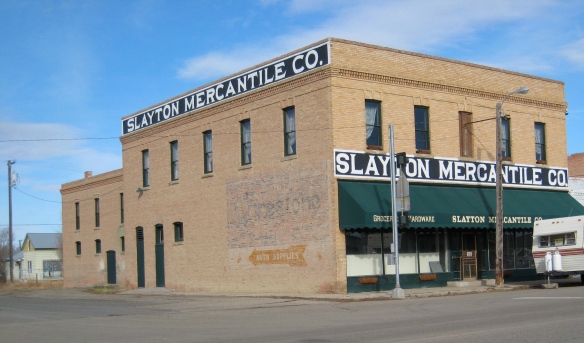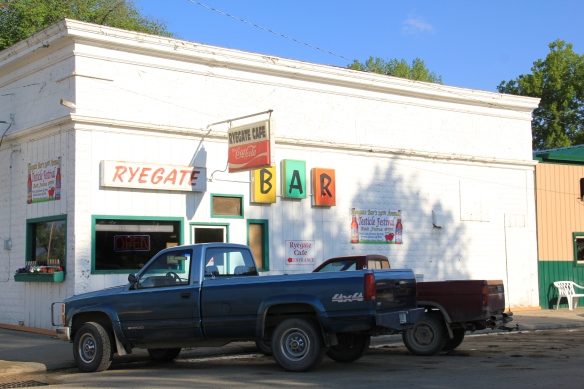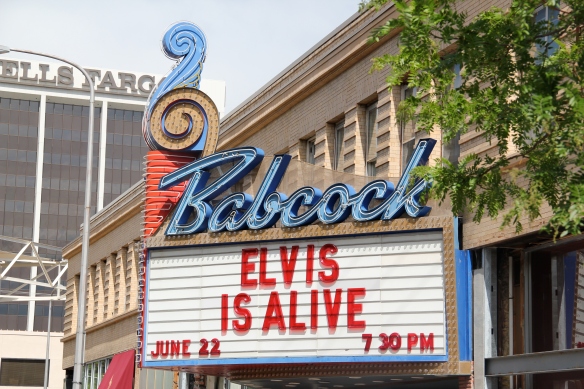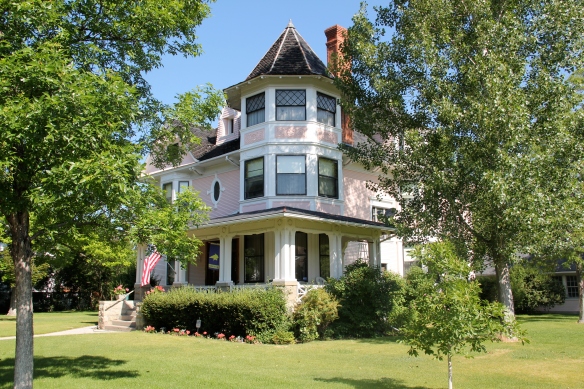
Abandoned Milwaukee Road corridor along U.S. Highway 12, Golden Valley County, MT, 1984
Golden Valley County, Montana, established with much local fanfare and excitement in 1920, was one of the last counties created in Montana. Today, with just over 1100 residents, it remains one of the county’s smallest in population. Yet, like other places along U.S. Highway 12, it has been a favorite jaunt of mine since 1982. The highway connects with Montana 3, which roughly parallels an old stagecoach route, and Highway 3 going south takes you directly to downtown Billings. Thus, beginning with my many projects with the Western Heritage Center in Billings in 1982, I quickly found out that taking U.S. 12 between Helena and Billings not only cut off miles from the journey but was always more scenic and more interesting due to the remnants of roadside architecture and bits of the Milwaukee Road corridor that followed the Musselshell River in this county.

U.S. 12 and Milwaukee Road routes along Musselshell River, Cushman, MT, 1984
As you leave Billings and head north of Montana 3, this state road intersects with U.S. 12 at Lavina, one of the county’s two incorporated towns, and a place that has held steady in population since 1980 (probably due to its location and proximity to Billings). The Adams Hotel, built in 1908 with a year of the railroad’s arrival, struck me immediately–a huge two-story Colonial Revival style building–in 1984 in the middle of nowhere. But the Adams,

listed in the National Register of Historic Places, spoke to the town founders’ hopes for the future–and the need for a large hotel for all of the traveling businessmen, and homesteaders, the Milwaukee planned to attract to the area. As the image above shows, in 1984 the Adams needed a friend–someone who would take on a huge frame building and find a new life for it. In the next decade that friend came and the Adams came back to life, as the 2006 digital image below shows.

The next decade has not been so kind. Owners have placed a clock in the cornice, eliminating the original dating of the building, plus brass lanterns have appeared on the second floor and it needs painting and repairs. But the building is still open, and in use, and those are huge steps toward compared to 30 years ago.

The town’s general store, Slayton Mercantile, which is also on the National Register, is doing better, and has become one of my frequent stops in the region. This two-story brick commercial building also spoke to town’s hope for a bright future in the second decade of the 20th century. Travelers along the road, and the town’s steady population, keep it in business today.

Slayton Mercantile, Lavina, MT, 2007

Slayton Mercantile, Lavina, MT, 2013
The historic two-story with full basement yellow brick Lavina Public School is not on the National Register but this early 20th century building is another key landmark. Its exterior architectural features speak to the restrained styles of public architecture often found in the region. Another community landmark is the joint United Methodist and Lutheran church of Lavina–the two congregations share this Gothic-styled early 20th century building to sustain it and themselves as viable congregations.


The fate of beautiful rural churches is not a happy story throughout the northern plains, but Golden Valley County has done better than many. Another of its early 20th century churches, the Lutheran Church at Barber, needed help in the early 1980s when I first surveyed it. Local residents in the last 30 years restored the building, opening it for services, and listed it in the National Register. The original open bell tower has been covered and a handicap ramp for attendees have been added–steps that have helped to keep the building part of the county’s otherwise disappearing historic landscape.

Barber Community Church, Golden Valley County, MT, 1984
Ryegate is the county seat and an important crossroads for ranchers and travelers. Its population too has remained relatively steady since the end of the Milwaukee Road in 1980–273 then and 245 in 2010. It was never a big place, with the largest population coming in 1920 when the county began, 405 residents. The historic grain elevators

speak to the importance of the railroad, and highway, while the landmark Ryegate Bar has served thirsty locals and travelers for decades. Today it is most famous for its annual testicle festival–a new tradition launched since the survey of 1984-1985.

Two buildings from the county’s beginnings are a one-story brick Classical style bank building, which like so many in the region closed its doors during the homesteader bust and the Great Depression, and the Golden Valley County Courthouse, appropriately the town’s most imposing building.


Ryegate also has its acknowledged historic sites: a town project in 1976 marked the area’s association with Chief Joseph’s 1877 trek across eastern Montana while on the

town’s eastern border the Sims-Garfield Ranch, a rambling assortment of vernacular-styled log and stone outbuildings and two vernacular style residences is the only town property listed in the National Register. Nestled between U.S. Highway 12 and the rocky bluffs of the Musselshell River, it is evocative of the county’s roots as a ranching landscape, a place of work and pride that survives today.











































































